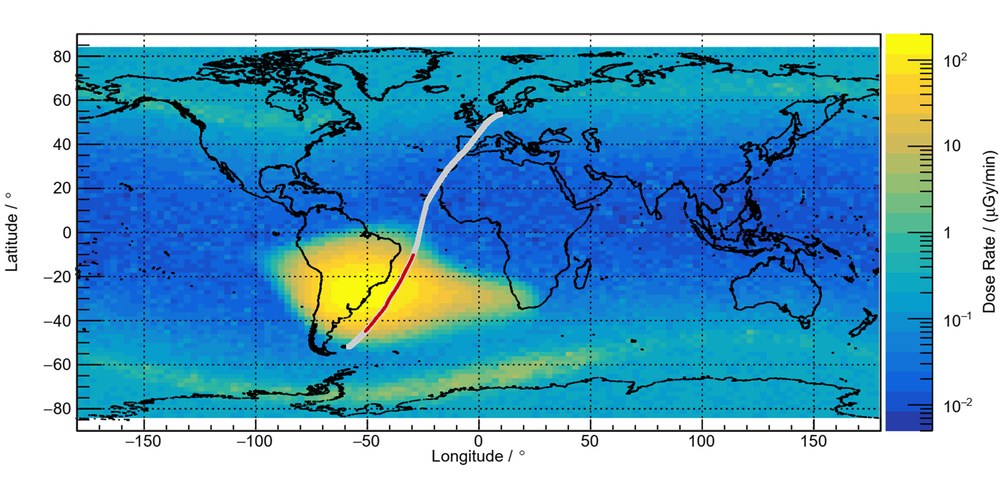No additional radiation at cruising altitude off the coast of Brazil


© Lufthansa

- Earth's atmosphere protects against the effects of the South Atlantic Anomaly even at an altitude of 13 kilometres.
- The radiation belts extend particularly close to Earth off the coast of Brazil. This is the geographical region of the South Atlantic Anomaly.
- A DLR research team verified its own model calculations using measurements performed on board a Lufthansa aircraft and enhanced findings from earlier flights.
- Focus: Aeronautics, radiation protection, space weather, medicine
Earth's atmosphere protects aircraft passengers and crew from the effects of the South Atlantic Anomaly. At cruising altitude, there is no additional exposure to cosmic radiation off the coast of Brazil. This was confirmed by a German Aerospace Center (Deutsches Zentrum für Luft- und Raumfahrt; DLR) research team during measurement flights. The results of the study, conducted as Atlantic Kiss mission, have now been published in a scientific journal by Nature.
The South Atlantic Anomaly is caused by a displacement of Earth's magnetic field. The axis of this field does not pass exactly through Earth's centre and is slightly shifted and tilted with respect to Earth's axis of rotation. This is why radiation belts surrounding Earth reach closer to the surface in the Atlantic Ocean off the Brazilian coast. In this area, referred to as the South Atlantic Anomaly, radiation levels in low-Earth orbit are elevated. This is apparent, for example, on the International Space Station ISS at an altitude of approximately 400 kilometres. At the cruising altitude of passenger aircraft, however, it is not noticeable. The DLR team took measurements up to an altitude of 43,000 feet. This corresponds to just over 13 kilometres.
"Fears of increased radiation exposure are scientifically unfounded"
"The data, which have now been evaluated in detail, have confirmed our model calculations," explains Matthias M. Meier from the DLR Institute of Aerospace Medicine, who led the Atlantic Kiss mission. "Our measurements have not revealed any indication of an additional significant contribution to the radiation field at flight altitudes in the geographical region of the South Atlantic Anomaly. The fear of increased radiation exposure at flight altitudes in this region is therefore scientifically unfounded."
In March and April 2021, three DLR researchers flew on board a Lufthansa Airbus A350-900 from Hamburg to Mount Pleasant (Falkland Islands) and back to Germany. The route passed right through the geographical region of the South Atlantic Anomaly. The DLR team was equipped with instruments to investigate various components of the radiation field. Among these instruments was a 40-kilogram neutron probe. This was fixed in its case in a row of seats at the aircraft's centre of gravity to reduce the influence of vibrations and turbulence during the flight. Four semiconductor detectors were used to record charged particles; two tissue-equivalent proportional counters measured the radiation energy absorbed by a very thin volume of tissue. Several additional passive detectors were also used.
Altogether, the results present a clear picture. Until now, only model calculations had been available for a flight altitude of 43,000 feet or 13 kilometres. Direct measurements by the DLR researchers on board aircraft had been only available for flights up to approximately 10 kilometres.
Measurements under stable space weather conditions
The results are particularly meaningful because during the period in 2021 in which the measurements were made, the Sun's influence on space weather was low. Solar activity was low and therefore space weather conditions were stable. "Solar activity drives the solar wind, which has a significant influence on how many energetic particles that originate elsewhere in the Galaxy reach Earth," says Meier. He led the Radiation Protection in Aviation working group at the DLR Institute of Aerospace Medicine in Cologne. During the Atlantic Kiss mission, the low solar activity meant that levels of cosmic radiation were comparatively intense. Life on Earth is protected from cosmic radiation by both Earth's magnetic field and the atmosphere.
